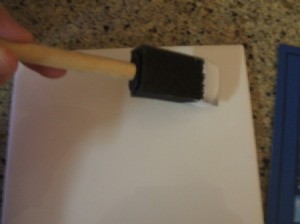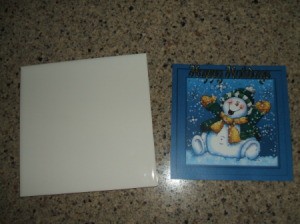 Many Uses For Christmas Cards:
Many Uses For Christmas Cards:Greeting Card Trivet Instructions:
Create a Christmas trivet from an inexpensive tile and a recycled Christmas card or wrapping paper. It can be displayed on an easel when not in use. Makes a great Christmas gift along with an inexpensive easel!
Supplies:
- white 6-inch glass tile
- Christmas card or wrapping paper
- Mod Podge
- foam brush
- scissors
- clear acrylic sealer
- felt or cork
- craft glue
 2. COVER THE TILE WITH A LAYER OF MODGE PODGE.
2. COVER THE TILE WITH A LAYER OF MODGE PODGE.  3. PLACE THE IMAGE OVER THE MODGE PODGE.
3. PLACE THE IMAGE OVER THE MODGE PODGE. - Apply Mod Podge over top of image.
- Allow Mod Podge to dry completely.
- Spray the tile with acrylic sealer and allow to dry.
- Apply a second coat if necessary and allow to dry.
- Cut cork or felt into squares to fit back of tile.
- Use hot glue or craft glue to adhere the backing to the tile.
Repinned FYI by: https://www.etsy.com/ca/shop/HummingbirdCove?ref=si_shop
Courtesy of: By Rachel's Mom from Wilkesboro, NC
*****************************************************************
MORE USES:
Don't throw away all the pretty Christmas cards you get away. There are so many things you can do with them. Everyone knows you can make postcards and name tags for gifts with them, but you can also cut out the design you might want to use when you scrapbook. Scrapbooking is a fun thing to do with them. You can also decoupage with them. You can use cards from birthdays, Valentine's Day, Easter, etc. to do your crafts with and not have to buy the pretty designs. I also decoupage my soap with the designs I have cut from the cards. There are so many things you can do with the pretty cards you have received. Have fun!
Repinned FYI by: https://www.etsy.com/ca/shop/HummingbirdCove?ref=si_shop
MORE USES:
Don't throw away all the pretty Christmas cards you get away. There are so many things you can do with them. Everyone knows you can make postcards and name tags for gifts with them, but you can also cut out the design you might want to use when you scrapbook. Scrapbooking is a fun thing to do with them. You can also decoupage with them. You can use cards from birthdays, Valentine's Day, Easter, etc. to do your crafts with and not have to buy the pretty designs. I also decoupage my soap with the designs I have cut from the cards. There are so many things you can do with the pretty cards you have received. Have fun!
Repinned FYI by: https://www.etsy.com/ca/shop/HummingbirdCove?ref=si_shop
Courtesy of: dwedenoja from New Creek, WV
*********************************************************************
GREETING CARD CD CASES COASTERS:
I use old greeting cards and scratched cds to make beautiful coasters. You make a template from a piece of acetate and place this so the part of the card you want to use is central. Cut out using scissors or craft knife then glue the picture to the cd. Cover in contact film and then glue felt circles on back.
You can also use family pictures or a themed topic such as animals/cars, etc., depending on who the gift is for. Make into sets for 4, 6 or 8 and give as a present.
Repinned FYI by: https://www.etsy.com/ca/shop/HummingbirdCove?ref=si_shop
Courtesy of: wildflower16
***********************************************************************
DECORATE GIFTS WITH RECYCLED GREETING CARDS
I am often without wrapping paper for a special occasion. I also keep a box full of cards that I have received, rather than pitch them. When a holiday comes around, it is fun to take a paper bag or white construction paper and use pictures from old cards, pasting them on, in any design needed. An animal here, a child there, tree, etc. You can tie it with string and add any item, like a piece of jewelry, a domino, or a paper clip to brighten it up.
For cards, you can do the same thing, and if creative, write your own personal verse or sketch. You can also use parts of photographs to make them more personal, especially if you have duplicates.
Repinned FYI by: https://www.etsy.com/ca/shop/HummingbirdCove?ref=si_shop
Courtesy of: Christine from Dayton, OH
*****************************************************************













 NATURAL COMFORTS & COSMETICS
NATURAL COMFORTS & COSMETICS
 I have compiled a rather impressive list of uses for 3%
I have compiled a rather impressive list of uses for 3% 

 Use hydrogen peroxide as a mouthwash to freshen breath. It kills the bacteria that causes halitosis. Use a 50/50 mixture of hydrogen peroxide and water.
Use hydrogen peroxide as a mouthwash to freshen breath. It kills the bacteria that causes halitosis. Use a 50/50 mixture of hydrogen peroxide and water. Use baking soda and hydrogen peroxide to make a paste for brushing teeth. Helps with early stages of gingivitis as it kills bacteria. Mixed with
Use baking soda and hydrogen peroxide to make a paste for brushing teeth. Helps with early stages of gingivitis as it kills bacteria. Mixed with 







